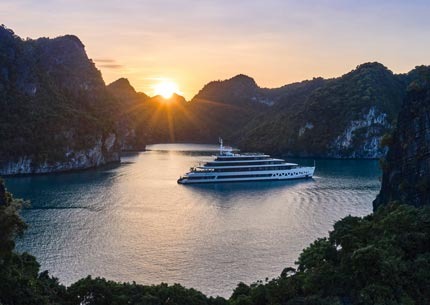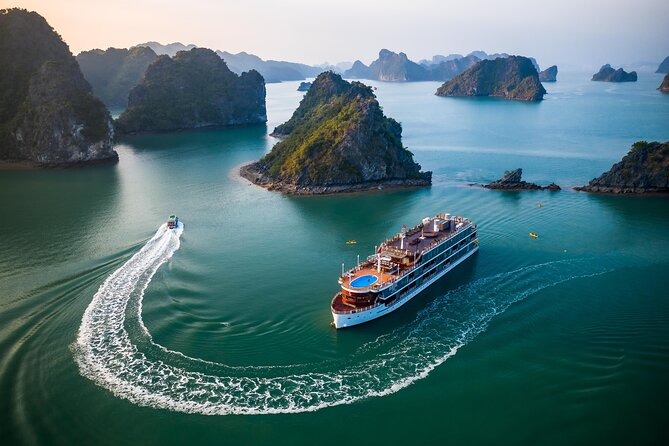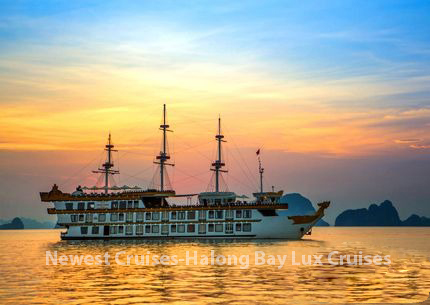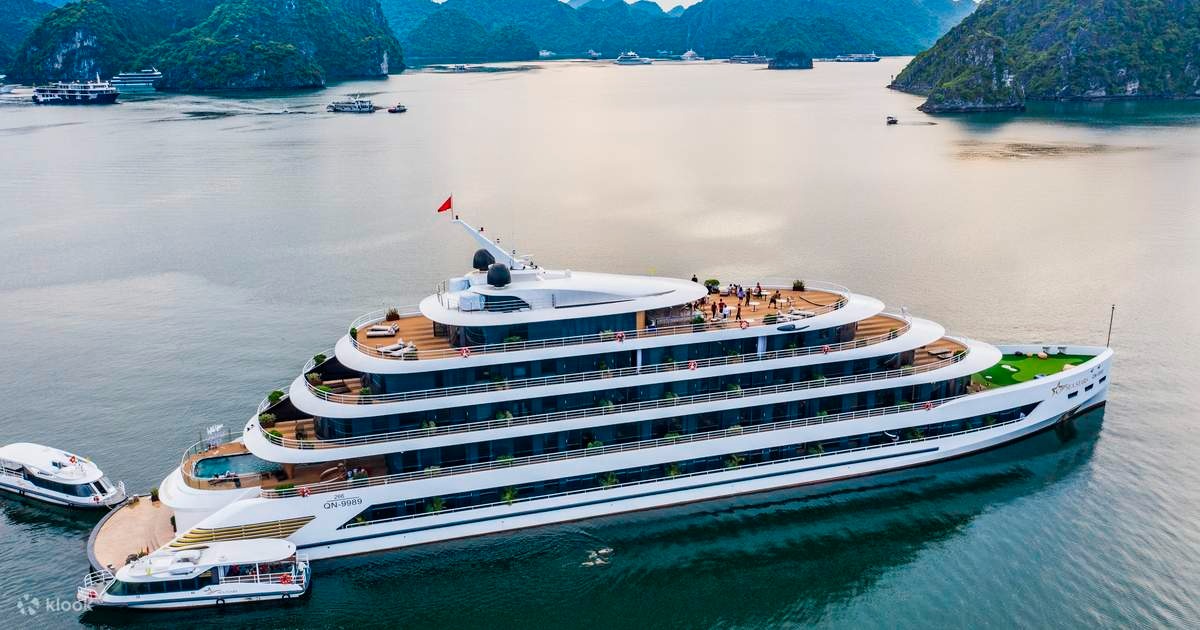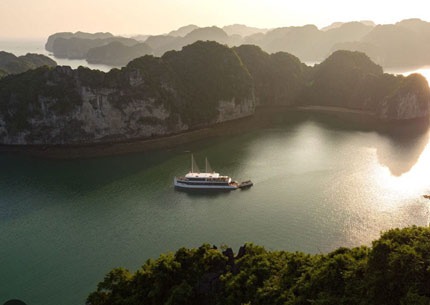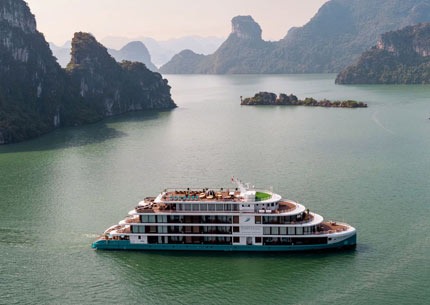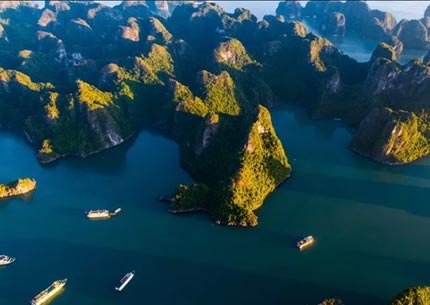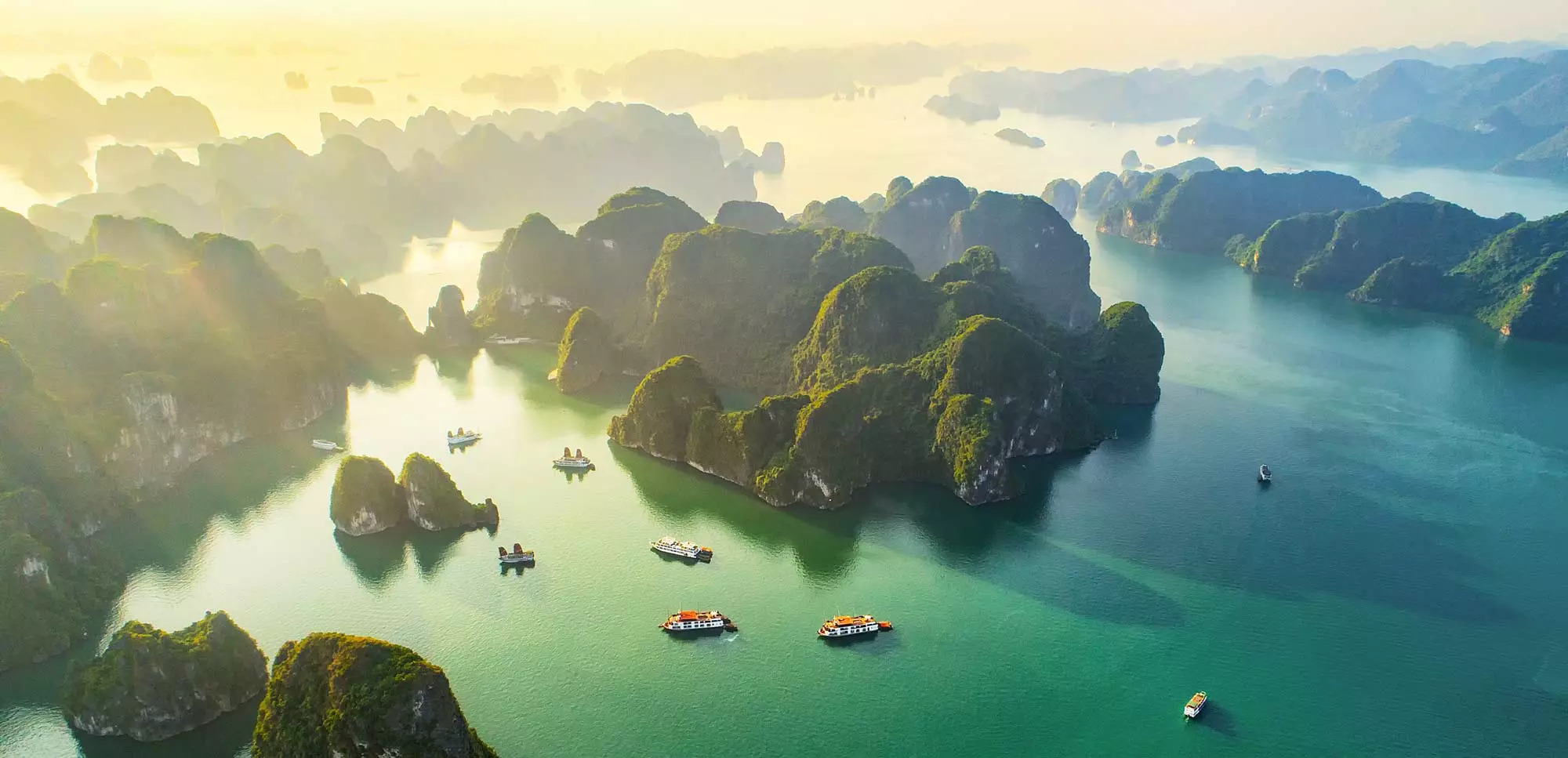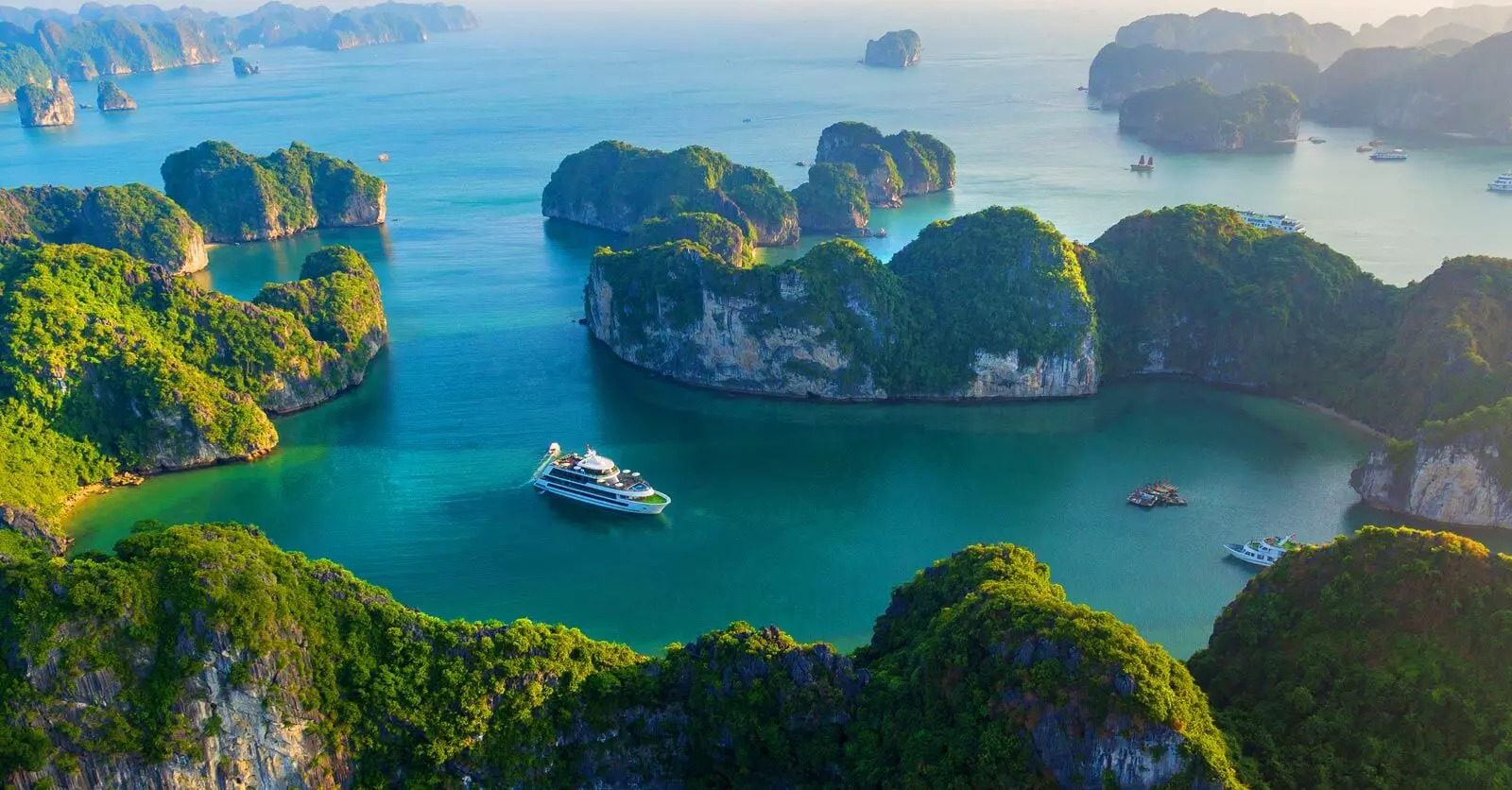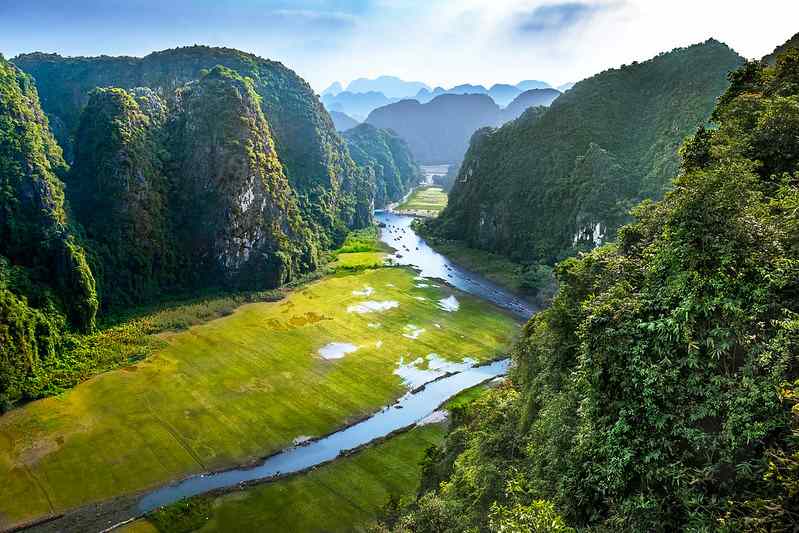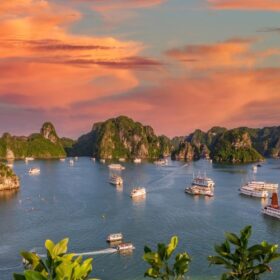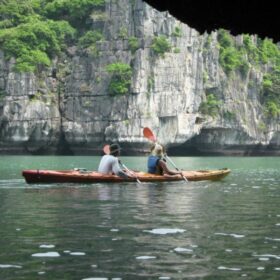Halong Bay vs Lan Ha Bay vs Bai Tu Long Bay: 17 Key Differences (2025-2026)
Northern Vietnam’s coastal jewels offer distinct experiences despite their geographic proximity. Wondering which emerald bay should be your next destination? Our comprehensive comparison reveals the unique character of each location to match your perfect travel style.
When planning a Vietnamese coastal adventure, travelers often face the dilemma of choosing between Halong Bay, Lan Ha Bay, and Bai Tu Long Bay. While these three breathtaking destinations share the same geological makeup of limestone karsts rising from turquoise waters, they each offer remarkably different experiences in terms of crowds, activities, and overall ambiance.
As 2025 approaches, understanding these differences becomes crucial for crafting your ideal vacation. Let’s explore what makes each bay special and which might be the perfect fit for your travel preferences.
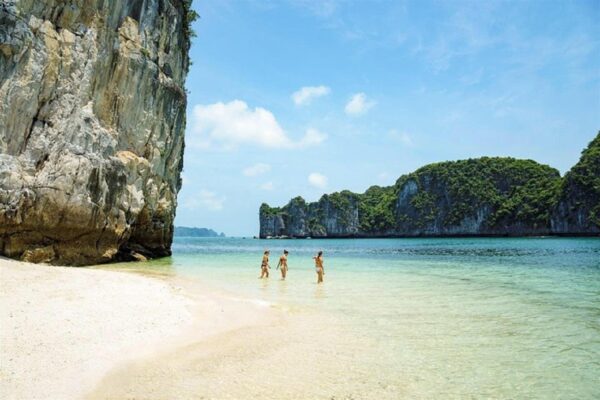
Geographic Location and UNESCO Status: Understanding the Basics
Where Exactly Are These Three Bays Located?
The three bays form part of the larger Gulf of Tonkin in northeastern Vietnam, but their exact locations differ:
- Halong Bay is situated entirely within Quang Ninh Province, approximately 170 km east of Hanoi. This iconic seascape covers an area of about 1,553 square kilometers and contains between 1,600-2,000 limestone islands and islets. It received UNESCO World Heritage Site status in 1994 and remains Vietnam’s most internationally recognized natural attraction.
- Lan Ha Bay lies just south of Halong Bay but falls within the administrative boundaries of Hai Phong Province. Covering approximately 300 square kilometers with 400+ karst islands, it wraps around the eastern and southern shores of Cat Ba Island. While technically not included in Halong Bay’s UNESCO designation, it shares identical geological characteristics.
- Bai Tu Long Bay extends northeast of Halong Bay in Quang Ninh Province, stretching all the way to the Chinese border. This expansive bay covers roughly 1,500 square kilometers and contains hundreds of islands, making it comparable in size to Halong Bay itself.
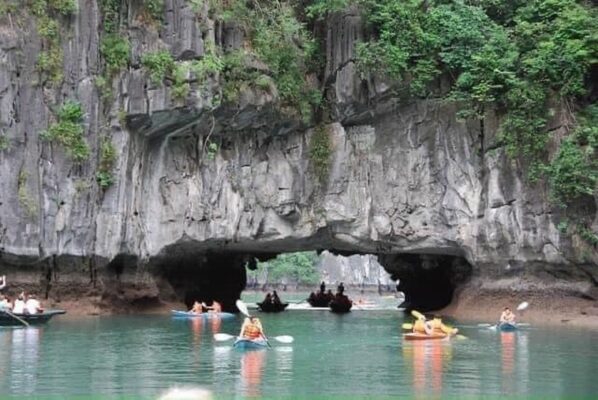
Protected Status and Conservation Efforts
While all three bays are protected to varying degrees, their conservation status differs:
- Halong Bay enjoys the highest level of protection as a UNESCO site and core area of the Halong Bay-Cat Ba Archipelago UNESCO Global Geopark established in 2018.
- Lan Ha Bay forms part of the Cat Ba Archipelago Biosphere Reserve (designated by UNESCO in 2004) and is included in the Halong Bay-Cat Ba Archipelago Geopark.
- Bai Tu Long Bay falls within Bai Tu Long National Park (established 2001), which protects both marine and terrestrial ecosystems across 15,783 hectares.
As of 2025, the Vietnamese government has implemented stricter environmental regulations across all three bays, including limitations on single-use plastics on cruises and reduced fishing zones to protect marine biodiversity.

Scenery and Natural Beauty: Subtle but Important Differences
Limestone Formations and Visual Impact
While the iconic limestone karsts are present throughout all three bays, subtle differences exist:
- Halong Bay’s limestone formations tend to be more dramatic and densely packed, creating the classic postcard vistas that have made it world-famous. The concentrated nature of these formations creates stunning corridors and passages between islands. Recent drone photography cataloging completed in 2024 confirmed Halong Bay has the highest density of karst formations per square kilometer among the three bays.
- Lan Ha Bay’s karsts are generally smaller but more vertical and often covered with more abundant vegetation. According to geological surveys completed in 2023, approximately 60% of Lan Ha’s islands are heavily forested compared to 45% in Halong Bay. The smaller scale creates a more intimate feeling when kayaking or cruising.
- Bai Tu Long Bay features more dispersed karst formations with greater distances between islands, creating a more expansive, open seascape. The karsts here tend to be larger in overall size but less jagged in profile. The greater spacing between formations offers enhanced visibility and breathing room compared to the more enclosed feeling of Halong Bay.
Water Color and Clarity Differences
Water conditions vary between the bays:
- Halong Bay typically displays emerald green waters with moderate visibility (3-5 meters on good days).
- Lan Ha Bay often boasts the clearest waters among the three, with visibility reaching 6-8 meters in optimal conditions, particularly around the bay’s southern reaches. Recent water quality monitoring from 2024 showed Lan Ha Bay had 28% higher visibility ratings than Halong Bay.
- Bai Tu Long Bay features a deeper blue-green water color with clarity that falls between the other two bays. The reduced boat traffic contributes to less water disturbance.
Beaches and Swimming Spots
Each bay offers different beach experiences:
- Halong Bay contains famous beaches like Ti Top, but these tend to be the most crowded. Beach access is generally limited to organized cruise stops.
- Lan Ha Bay shines with approximately 139 small white-sand beaches scattered among its islands, many accessible only by kayak or small boat. These include the stunning Three Peach Beaches (Ba Trai Dao) and Van Boi Beach, where the fine sand and clear waters offer superior swimming conditions.
- Bai Tu Long Bay features fewer traditional beaches but compensates with secluded coves and hidden lagoons. Beaches like those on Quan Lan Island tend to be larger but more remote.

Tourism Development and Crowd Levels in 2025
Visitor Statistics and Boat Traffic
The latest tourism data reveals stark differences in visitor volume:
- Halong Bay continues to be Vietnam’s busiest marine destination with approximately 4.8 million annual visitors (2024 data from Quang Ninh Tourism Department). On average days, 500-550 tourist vessels operate in its waters simultaneously, creating notable congestion at popular sites.
- Lan Ha Bay receives approximately 1.2 million annual visitors, with peak daily boat counts reaching around 150-180 vessels. This represents a 35% increase from 2023 levels as more travelers discover this alternative.
- Bai Tu Long Bay remains the least visited, welcoming approximately 800,000 annual visitors with typically fewer than 90 boats operating concurrently. This represents a conscious decision by authorities to maintain lower density tourism in this region.
Tourism Infrastructure and Development Levels
The three bays show distinct development patterns:
- Halong Bay features comprehensive tourism infrastructure with multiple large marinas (Tuan Chau and Bai Chay being the primary departure points), numerous hotels, and entertainment complexes along the mainland shore. The Halong Bay Management Board has implemented a sophisticated vessel tracking system to manage the high boat density.
- Lan Ha Bay’s infrastructure is centered around Cat Ba Island and Got Pier in Hai Phong. While developing rapidly, it maintains a more low-key atmosphere with boutique accommodations rather than mega-resorts. The 2023 opening of the Hai Phong-Cat Ba highway bridge has increased accessibility significantly.
- Bai Tu Long Bay has the most limited infrastructure, with fewer departure ports and accommodation options, primarily concentrated around Hon Gai port and Van Don. This limited development preserves the area’s tranquility but means fewer convenience amenities.
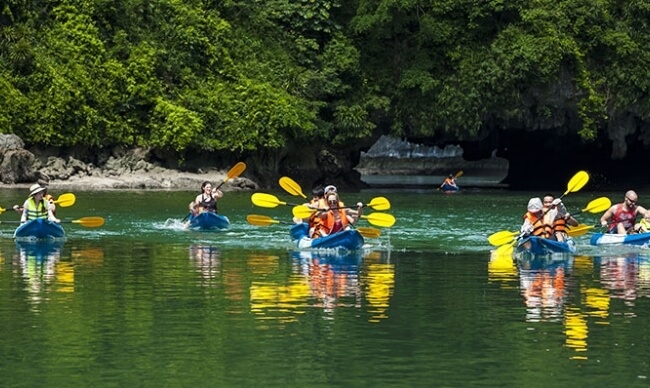
Regulations and Access Restrictions
As of 2025, management approaches differ:
- Halong Bay operates under strict routing regulations with designated anchoring zones and timed access to major attractions to manage overcrowding.
- Lan Ha Bay implemented a new zoning system in 2024 that restricts certain areas to licensed low-impact vessels only, creating preservation zones where motorized craft are prohibited.
- Bai Tu Long Bay maintains the strictest environmental regulations, with limitations on daily visitor numbers and larger no-fishing zones to protect marine ecosystems.
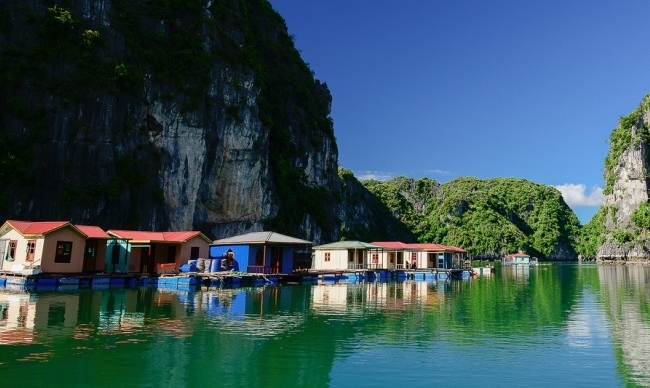
Cruise Experiences and Itinerary Options
Cruise Styles and Fleet Differences
The cruise experience varies significantly between bays:
- Halong Bay offers the widest range of cruise options, from budget day trips (starting around $50) to ultra-luxury vessels exceeding $500 per night. The fleet consists of approximately 500 registered boats ranging from traditional wooden junks to modern steel ships. Most vessels carry between 20-45 passengers, with an average cabin count of 12-18 rooms.
- Lan Ha Bay specializes in boutique luxury experiences with smaller vessels typically carrying 12-24 passengers in 8-14 cabins. These cruises tend to emphasize personalized service with higher staff-to-guest ratios. The fleet here is newer on average, with many vessels constructed after 2018 incorporating more modern amenities and eco-friendly systems.
- Bai Tu Long Bay features the smallest fleet but with higher average quality. Most cruises operating here are in the premium to luxury category, with vessels carrying 16-30 passengers. Traditional wooden junk designs predominate, creating a more authentic aesthetic.
Typical Itineraries and Highlights
Cruise itineraries highlight different attractions:
- Halong Bay 2-day itineraries typically focus on famous sites like Sung Sot (Surprise) Cave (the largest in the region at 10,000 square meters), Ti Top Island for panoramic views, Luon Cave for kayaking, and the floating villages of Cua Van or Vung Vieng. Routes tend to cover the bay’s southwestern portion due to time constraints.
- Lan Ha Bay 3-day cruises often include Dark & Bright Cave complex, Three Peach Beaches, Tra Bau area for pristine kayaking, and excursions to Cat Ba Island’s national park, where hiking trails lead through primary rainforest home to endangered Cat Ba langur monkeys (fewer than 70 remain in the wild).
- Bai Tu Long Bay itineraries typically include Thien Canh Son Cave, Vung Vieng floating fishing village (more authentic than those in Halong Bay with actual resident fishermen), Cong Dam geological area, and Ban Chan Beach. Routes generally explore the central and southern portions of the bay.
Onboard Amenities and Activities
The onboard experience varies between bays:
- Halong Bay cruises often feature entertainment-focused amenities like karaoke lounges, larger sun decks for socializing, cooking demonstrations, and evening squid fishing. Many vessels include spa services and onboard shopping.
- Lan Ha Bay vessels typically emphasize outdoor activities with extensive kayaking programs, swimming platforms, onboard gear for snorkeling, and educational components focused on the local ecosystem. Wellness options like sunrise tai chi and yoga sessions are common.
- Bai Tu Long Bay cruises often highlight cultural immersion with visits to local communities, fishing demonstrations with traditional methods, and more authentic Vietnamese culinary experiences. The pace tends to be more relaxed with longer anchoring periods in scenic locations.
Activities and Attractions: What Can You Actually Do?
Cave Exploration and Geological Wonders
Each bay offers distinct cave experiences:
- Halong Bay’s caves are the most developed and accessible, with Sung Sot Cave featuring colored lighting and concrete pathways accommodating up to 1,000 visitors daily. Other notable caves include Thien Cung (Heavenly Palace) Cave with its impressive stalactite formations and Me Cung (Maze) Cave with its challenging passageways. These caves benefit from professional lighting systems but can feel crowded during peak hours.
- Lan Ha Bay’s caves tend to be smaller but more adventurous, often requiring kayaking to access. Dark & Bright Cave complex allows visitors to paddle through a mountain into hidden lagoons. Hospital Cave on Cat Ba Island offers historical interest as a former Viet Cong field hospital and bomb shelter during the American War. These caves remain largely in their natural state with minimal artificial modifications.
- Bai Tu Long Bay features less-visited but impressive caves like Thien Canh Son Cave with its pristine stalactites and natural skylights. Vung Vieng Cave combines geological interest with cultural significance as a historical shelter for local fishing communities. Visitor numbers are strictly controlled, allowing for more contemplative exploration.
Water Activities and Beach Experiences
Water-based activities vary by location:
- Halong Bay offers structured swimming and kayaking sessions at designated spots like Ti Top Beach and Luon Cave, but these experiences often feel programmed and can be crowded. The 2024 kayaking regulations limit routes to specific corridors due to heavy boat traffic.
- Lan Ha Bay excels in water activities with extensive kayaking networks through arches and lagoons, particularly in the less restricted southwestern portions. The 2023 establishment of dedicated kayaking zones has created safe paddling areas away from larger vessels. Swimming from boats is permitted throughout most of the bay rather than at designated stops only.
- Bai Tu Long Bay provides the most natural swimming and kayaking, with opportunities to explore untouched areas. The 2024 environmental impact assessment confirmed its waters contain 25% higher marine biodiversity than Halong Bay, making it superior for wildlife spotting while snorkeling or kayaking.
Cultural Experiences and Local Interactions
The cultural dimension differs significantly:
- Halong Bay’s floating villages have largely transformed into tourism operations, with most actual residents relocated to the mainland. Cultural demonstrations tend to be staged for visitors rather than authentic daily life.
- Lan Ha Bay offers more genuine fishing community interactions, particularly around Cat Ba’s floating villages where fishermen continue traditional practices. The 2024 “Living Culture” initiative provides economic incentives for maintaining traditional lifestyles while accommodating tourism.
- Bai Tu Long Bay delivers the most authentic cultural experiences, with functioning fishing communities at Vung Vieng and Cong Dam. Visitors can participate in actual fishing operations, and the craft traditions of pearl cultivation and net weaving continue as working practices rather than demonstrations.
Accessibility and Practical Considerations
Getting There: Transportation Options in 2026
Access methods and travel times vary significantly:
- Halong Bay is reached via the Hanoi-Haiphong-Halong Expressway in approximately 2-2.5 hours from Hanoi. Most cruises depart from Tuan Chau Marina or Bai Chay Port. The high-speed Cat Ba Express ferry also connects Hai Phong city to Tuan Chau in 30 minutes.
- Lan Ha Bay is primarily accessed via three routes: from Hanoi to Got Pier (Hai Phong) in 2 hours, followed by direct boarding; via the Hanoi-Cat Ba bus-ferry combination (3.5 hours); or through the new Cat Ba-Hai Phong bridge highway (opened 2023), reducing travel time from Hanoi to 2.5 hours. The 2024 expansion of Got Pier has increased departure capacity by 40%.
- Bai Tu Long Bay cruises typically depart from Hon Gai Port in Halong City (2.5 hours from Hanoi) or from the newer Van Don Port (3 hours from Hanoi). The 2023 completion of the Van Don International Airport now offers direct flights from major Vietnamese cities, though international connections remain limited.
Weather Considerations and Seasonal Variations
Climate affects the bay experience differently:
- Halong Bay’s peak season runs from October to April, with clearest skies from November to February. Summer months (June-August) bring higher temperatures (averaging 32-34°C) and occasional typhoon risks, though the bay’s islands provide some shelter from rough seas.
- Lan Ha Bay tends to have slightly more rainfall (annual average of 1,900mm vs. Halong’s 1,700mm) but benefits from Cat Ba Island’s sheltering effect during stormy weather. The 2024 meteorological data indicates Lan Ha experiences approximately 20% fewer cruise cancellations during typhoon season.
- Bai Tu Long Bay is more exposed to weather patterns from the open sea, making it slightly more susceptible to cancellations during inclement weather. However, the northeastern location provides exceptional sunrise views, with morning light conditions rated superior for photography.
Pricing and Budget Considerations
Cost structures differ between destinations:
- Halong Bay offers the widest price range: Budget day cruises start around $80-100 per person, mid-range overnight experiences from $150-220, and luxury options from $250-500+ per night. The highest concentration of budget options exists here, but premium experiences often come with crowding trade-offs.
- Lan Ha Bay trends toward mid-range and upscale options: Day trips start from $100-130, quality overnight cruises from $180-250, and luxury experiences from $280-550. The 2024 pricing analysis shows approximately a 15-20% premium over equivalent Halong Bay options, justified by less crowded conditions.
- Bai Tu Long Bay focuses almost exclusively on premium experiences: Few budget options exist, with overnight cruises starting from $200-280 and luxury options from $300-600. The higher pricing reflects the exclusivity, lower density, and often all-inclusive nature of these cruises.
Making Your Decision: Which Bay Suits Your Travel Style?
Best Bay for First-Time Visitors to Vietnam
For first-time visitors to Vietnam with limited time:
- Halong Bay remains the classic choice for those seeking iconic views featured in travel magazines and Vietnam promotional materials. Its UNESCO status and comprehensive tourism infrastructure make it the most straightforward option, particularly for travelers uncomfortable with ambiguity or seeking maximum convenience.
- However, first-timers with 2-3 days available should seriously consider Lan Ha Bay for its balance of accessibility, beauty, and moderate crowd levels. The 2024 Vietnam Tourism Authority satisfaction surveys show first-time visitors to Lan Ha reported 22% higher overall satisfaction than those visiting Halong Bay.
Ideal Choice for Different Traveler Types
Different travelers will prefer different bays:
- Solo travelers and social groups often prefer Halong Bay for its lively atmosphere and opportunities to meet other travelers. The party boats operating in this region (though increasingly regulated) provide nightlife options not found in the other bays.
- Couples and honeymooners typically find Lan Ha Bay ideal, balancing romantic seclusion with comfortable amenities. The small beaches accessible only by kayak provide private moments impossible to find in Halong Bay.
- Families with children benefit from Bai Tu Long Bay’s relaxed pace and educational opportunities. The absence of large crowds creates a safer environment for young explorers, while the authentic cultural interactions offer valuable learning experiences.
- Photography enthusiasts increasingly favor Bai Tu Long Bay for landscape shots due to less boat traffic in frames, while wildlife photographers prefer Lan Ha Bay for its higher biodiversity and proximity to Cat Ba National Park.
Length of Stay Recommendations
Time considerations affect bay choice:
- For single-day excursions (not recommended but sometimes necessary), Halong Bay provides the most efficient experience, allowing visitors to see iconic formations within a concentrated area.
- For the typical 2-day/1-night cruise, Lan Ha Bay offers the best value proposition, balancing scenery, activities, and reduced crowding within the standard timeframe.
- For 3-day/2-night experiences, Bai Tu Long Bay excels by allowing visitors to reach the more remote northeastern sections that few tourists ever see, with some cruises venturing as far as Co To Island’s pristine beaches.
The Verdict: 2026’s Best Bay Experience
As we navigate through 2025, each bay continues to evolve in response to tourism trends and environmental considerations:
- Halong Bay maintains its iconic status but struggles with balancing tourism volume and preservation. Its strength remains the concentration of dramatic formations and comprehensive infrastructure. Choose Halong if you prioritize convenience, iconic views, and don’t mind sharing the experience with others.
- Lan Ha Bay has emerged as the best all-around option for most travelers, offering 80% of Halong’s scenic beauty with 50% of the crowds. Its proximity to Cat Ba Island adds valuable diversity to the experience. Select Lan Ha if you seek a balance between accessibility and authenticity with superior water activities.
- Bai Tu Long Bay continues as the premium choice for those seeking the most serene experience and willing to pay somewhat more for exclusivity. Choose Bai Tu Long if tranquility and immersion matter more than photographing specific famous landmarks.
The growing consensus among travel experts is that Lan Ha Bay represents the optimal balance for most visitors in 2025, though all three destinations offer remarkable experiences when approached with appropriate expectations.
Frequently Asked Questions
Can I visit more than one bay during a single cruise?
Yes, but with limitations. Some cruises marketed as “Halong Bay” actually visit parts of Lan Ha Bay, particularly those operating 3-day itineraries. However, very few standard cruises combine Halong and Bai Tu Long Bays due to distance. For comprehensive exploration of all three bays, consider:
- Private charter boats that create custom itineraries (starting from $1,200/day)
- Specialized 4-5 day cruises that specifically advertise multi-bay exploration
- Land-based stays on Cat Ba Island combined with day cruises to different areas
When is the absolute best time to visit these bays?
While each bay has slightly different optimal times:
- Late September to early November offers the best overall conditions across all three bays, with comfortable temperatures (24-28°C), reduced rainfall, good visibility, and moderate crowd levels.
- Late February to April provides the second-best window, with warming temperatures and good visibility before the summer crowds arrive.
Avoid major Vietnamese holidays, particularly Tet (Lunar New Year) when domestic tourism peaks and prices surge by 30-50%.
Are these bays suitable for travelers with mobility limitations?
Accessibility varies significantly:
- Halong Bay offers the most accessible options with several cruise boats featuring elevators, wheelchair ramps, and accessible cabins. Major caves like Sung Sot have implemented wheelchair-accessible routes for the main sections.
- Lan Ha Bay has limited accessibility options with only a handful of newer vessels accommodating wheelchairs. Most activities require moderate mobility.
- Bai Tu Long Bay presents the most challenges for mobility-impaired travelers, with fewer adapted vessels and more adventurous excursions.
Always communicate specific needs when booking to ensure appropriate accommodations.
How do the safety standards compare between the three bays?
Safety regulations have standardized across all three bays following the 2023 Maritime Safety Enhancement Act:
- All overnight vessels must meet identical safety equipment standards, including automated fire suppression systems and minimum crew certification requirements.
- Halong Bay’s higher boat density creates inherently higher collision risks, though traffic management systems mitigate this concern. The bay recorded 3 minor incidents in 2024.
- Lan Ha and Bai Tu Long Bays benefit from reduced congestion but sometimes have longer emergency response times due to greater distances from rescue services.
Can I swim safely in these bays?
Swimming conditions vary seasonally and by location:
- November through April: Water temperatures range from 19-24°C, with jellyfish rarely present. Swimming is generally safe in designated areas.
- May through October: Warmer water (25-30°C) but increased jellyfish presence, particularly box jellyfish in some areas. Always follow crew guidance about swimming safety.
- Lan Ha Bay consistently offers the best swimming conditions with clearer water and more dedicated swimming areas.
- All reputable cruises provide life jackets and supervise swimming activities.
Ready to experience the magic of Vietnam’s most beautiful bays? Halong Bay Lux Cruises offers premium cruise experiences across all three destinations, with expert guidance to help you select the perfect journey for your travel style. Our 2-day Halong and Lan Ha Bay cruises deliver the perfect introduction for time-conscious travelers, while our 3-day luxury experiences provide the comprehensive exploration that these magnificent seascapes deserve.
Contact our expert team today to craft your perfect 2025 bay adventure!
Book your luxury Halong Bay experience
Contact Halong Bay Lux Cruises now via Hotline | WhatsApp: +84.978.358.422 for pricing and special offers!
Thousands of travelers from Europe, UK, USA, and Australia have rated us 5-stars for our exceptional service and unforgettable Halong Bay luxury experience.
- Hotline | WhatsApp: +84.978.358.422
- Phone | WhatsApp: +84.962.261.687
- Email: halongbayluxcruises@gmail.com or vietnammarveltravel@gmail.com
- Website: halongbayluxcruises.com
- Reviews: Top Halong Bay Cruise Reviews on TripAdvisor
- Fanpage: https://www.facebook.com/halongbayluxcruises

